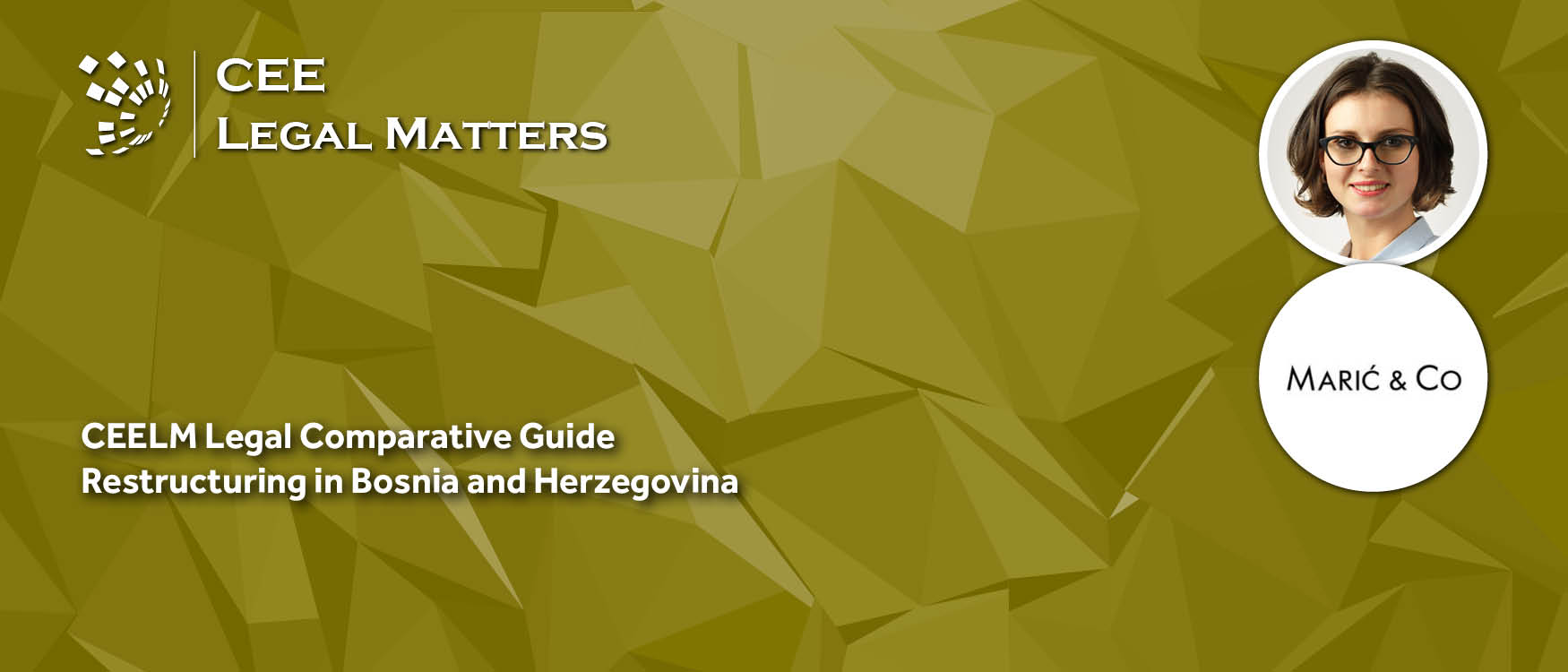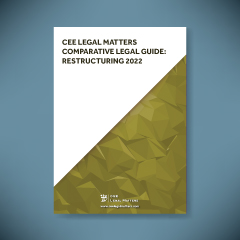Contributed by Maric & Co.
1. Overview
1.1. What domestic pieces of legislation and international instruments apply to restructuring and insolvency matters in your jurisdiction?
The Law on Bankruptcy of Federation of Bosnia and Herzegovina; the Law on Bankruptcy of RS and the Law on Bankruptcy of Brcko District BiH
1.2. Do you have a well-established legal regime governing restructuring and insolvency, or do you have rather frequent legislative changes in the area?
Legislative changes in the area of the Law on Bankruptcy of FBiH were quite frequent, with amendments occurring in 2003, 2004, 2006, and 2018. In July 2021, the new Law on Bankruptcy of FBiH entered into force. The Law on Bankruptcy of RS was not amended after 2016, while the Law on Bankruptcy of Brcko District BiH was adopted in 2019, and changes were made to it in 2020 and 2022.
1.3. Are there any special regimes applying to specific sectors?
No.
1.4. Were any changes to restructuring or insolvency laws adopted in response to the COVID-19 pandemic? If so, what were they?
There were no changes in the law specifically related to COVID-19. However, the adoption of the new Law on Bankruptcy of FBiH and the introduction of restructuring in pre-bankruptcy proceedings has probably facilitated the process for some companies that may have fallen into crisis due to the consequences caused by COVID-19.
1.5. Are there any proposed or upcoming changes to the restructuring insolvency regime in your country?
No.
1.6. Has your country adopted or is your country considering the adoption of the UNCITRAL Model Law on Enterprise Group Insolvency?
No.
2. Insolvency
2.1. Is there an insolvency test that triggers certain obligations for directors or officers of the debtor company? If so, what is the test and what are the consequences for failure to meet these obligations?
The management of the debtor is obliged to monitor the financial performance of the company and if the insolvency conditions are met, they are under the obligation to initiate the proceeding, within 60 days. If not initiated, the management may be fined, as well as sued for damages that occurred due to failure to timely file.
2.2. What types of insolvency procedures are established by law in your jurisdiction?
The Law on Bankruptcy of FBiH and the Law on Bankruptcy of Brcko District BiH regulates pre-bankruptcy proceedings and bankruptcy proceedings, legal consequences of opening and conducting pre-bankruptcy proceedings and bankruptcy proceedings, reorganization of a bankrupt debtor unable to pay on the basis of a bankruptcy plan, and international bankruptcy.
The Law on Bankruptcy of RS regulates restructuring procedures and bankruptcy procedures, legal consequences that are regulated to the opening and implementation of restructuring and bankruptcy proceedings, bankruptcy reorganizations of the debtor unable to pay based on bankruptcy plan, and international bankruptcy.
2.3. Who has the right to initiate insolvency proceedings?
Bankruptcy proceedings are initiated by a written proposal. The bankruptcy debtor and every creditor who has a legal interest in conducting a bankruptcy proceeding are authorized to submit a proposal for the opening of the bankruptcy proceeding.
2.4. What are the consequences of commencing insolvency proceedings, in particular:
2.4.1. Does management continue to operate the business and/or is the debtor subject to supervision?
With the opening of a bankruptcy proceeding, the rights of the bankrupt debtor to manage and dispose of the assets belonging to the bankruptcy estate, as well as the rights of the bodies of the bankrupt debtor, procurators, representatives, and attorneys of the bankrupt debtor, are transferred to the bankruptcy trustee.
2.4.2. Does a moratorium or stay apply and if so, can it have an extraterritorial effect?
During the pre-bankruptcy proceeding, on the day of the opening of the pre-insolvency restructuring procedure all pending court proceedings, administrative, litigation, or enforcement are suspended and new actions against the debtor are not allowed, with the exception of any criminal proceedings. In FBH and the Brcko District, within 15 days after the examination hearing, any suspended litigation proceedings regarding the debtor can be resumed upon the request of such a creditor, while in the RS such proceedings can be resumed after the finality of the settlement/decision on termination of the pre-bankruptcy proceeding. Once the bankruptcy proceedings are opened, all court pending court proceedings, administrative, litigation, or enforcement are suspended until the completion of the proceeding (unless the conditions for the continuation of the proceeding are fulfilled).
2.4.3. How does it impact the existing contracts (e.g., is the counter-party free to terminate them, can the debtor’s pre-insolvency transactions be challenged)?
The bankruptcy trustee can, if the bankrupt debtor or another contracting party at the time of opening the bankruptcy proceeding has not fulfilled or has not fully fulfilled the bilaterally binding contract, instead of the bankrupt debtor, fulfill the contract and fulfill the request from the other party. If the bankruptcy trustee refuses to perform, the other party can assert its claim due to non-performance only as a bankruptcy creditor.
If the time of delivery of an obligation under a fixed contract falls due after the opening of a bankruptcy proceeding, fulfillment cannot be claimed. The other contracting party with the bankruptcy debtor may assert a claim for compensation for non-performance as a bankruptcy creditor.
2.5. Which steps do insolvency proceedings normally include and what are the roles of the courts and other key stakeholders (such as debtor, directors of the debtor, shareholders of the debtor, secured creditors, unsecured creditors, etc.)?
Bankruptcy proceedings are initiated by a written proposal. The bankruptcy debtor and every creditor who has a legal interest in conducting bankruptcy proceedings are authorized to submit a proposal. When the court receives the proposal, it is obliged to review the proposal within 15 days, and if it determines that the proposal is incomplete and that certain documentation is missing, then the proposal is returned to the proposer. By its legal nature, bankruptcy proceedings are urgent and all deadlines must be shortened in the shortest possible time. Based on the proposal for initiation of bankruptcy proceedings, the bankruptcy judge issues a decision on the initiation of preliminary bankruptcy proceedings in order to determine the conditions for opening the bankruptcy proceedings. During the previous procedure, the contractual party of the bankrupt debtor cannot cancel the permanent obligation relationship. The bankruptcy judge will schedule a hearing regarding the conditions for opening bankruptcy proceedings after receiving the report of the temporary bankruptcy trustee and will make a decision to open bankruptcy proceedings or reject a motion to open bankruptcy proceedings within three days of the conclusion of the court hearing. If bankruptcy proceedings are opened, the bankruptcy judge will appoint a bankruptcy trustee. The bodies of the bankruptcy procedure are the bankruptcy judge, the bankruptcy trustee, the assembly of creditors, and the board of creditors. The bankruptcy judge conducts and manages the bankruptcy proceeding from the submission of the proposal until the end of the bankruptcy proceeding and makes final and binding decisions. The most important decision of the bankruptcy judge is the appointment of the bankruptcy trustee. When a bankruptcy trustee is appointed, he must immediately take possession of the assets of the bankrupt debtor and immediately take the necessary measures in the inventory of assets, and the implementation of all other decisions made by the assembly of creditors. The bankruptcy judge supervises the work of the bankruptcy trustee. The third body in bankruptcy proceedings is the assembly of creditors. The creditors’ assembly is convened by the bankruptcy judge. The fourth body is the board of creditors, which is elected by the assembly from the circle of creditors, and its members are bankruptcy creditors with the highest claims, creditors with small claims, representatives of employees of the bankrupt debtor, and various creditors. The creditors’ committee considers the bankruptcy trustee’s reports on the course of the bankruptcy proceeding and the state of the bankruptcy estate, giving an opinion on the liquidation of the bankruptcy estate, submitting complaints to the court about the work of the bankruptcy trustee, etc. With the opening of bankruptcy proceedings, the rights of the bankrupt debtor to manage and dispose of the assets belonging to the bankruptcy estate, as well as the rights of the bodies of the bankrupt debtor, procurators, representatives, and attorneys of the bankrupt debtor, are transferred to the bankruptcy trustee.
2.6. In insolvency proceedings, do specific stakeholders’ claims enjoy priority (e.g., employees, pension liabilities)? Can the claims of any class of creditor be subordinated (e.g., equitable subordination)?
In Federation of BiH and Brcko District BiH, before other bankruptcy creditors, the employees and former employees of the bankrupt debtor, except for the members of the company’s management, members of the supervisory board, and the audit committee, are settled with employment claims incurred up to the date of opening of bankruptcy proceedings in the total gross amount, severance pay up to the amount prescribed by law or collective agreement and claims based on compensation for damages suffered due to an injury at work or occupational disease and family members of an employee who died at work, which is paid in full.
In RS, claims that enjoy priority are:
1) claims originating from the period of the temporary administration and claims, which could not be settled by either the temporary trustee or the bankruptcy trustee, are settled before other bankruptcy creditors,
2) claims of the employees of the bankrupt debtor from the employment relationship for the last 12 months to the day of the opening of bankruptcy proceedings, but only in the amount of the lowest salary established by law and calculated contribution to the lowest salary;
3) claims of workers who exercise the right to compensation for injuries at work and family members of the deceased workers at work, which is paid in full
2.7. What is a timeline for insolvency proceedings and how are they finalized?
Bankruptcy proceedings will be completed within one year, and, in complex cases, within two years from the day bankruptcy proceedings were opened. If the bankruptcy proceeding is not completed within one or two years, the procedure will continue and it may last one more year at most, and the bankruptcy judge will inform the president of the court about the reasons for extending the deadline.
After the bankruptcy trustee submits a report on the completed division, evidence of the completed division, and after the auditor’s report on the evaluation of the final account in the bankruptcy proceedings is delivered, the bankruptcy judge will issue a decision on the conclusion of the bankruptcy proceeding.
2.8. Are there any liabilities that survive the insolvency proceedings?
Should the insolvency proceedings be concluded, but certain assets found thereafter, the court will order that the bankruptcy creditors be settled from such assets in accordance with the rules of the bankruptcy procedure.
3. Restructuring
3.1. What formal and informal restructuring proceedings are available in your country?
The bankruptcy laws of FBiH, RS, and Brcko District BiH proscribe financial and operational restructuring, which is a procedure led by the court with the aim of concluding an agreement in a pre-bankruptcy proceeding between creditors and debtors on the method of settling creditors’ claims in order to improve the liquidity and solvency of the debtor.
3.2. What are the entry requirements to restructuring and how are restructuring plans approved and implemented?
A restructuring plan can be drawn up and proposed only after the opening of bankruptcy proceedings. After bankruptcy proceedings are opened, the bankruptcy trustee and the bankruptcy debtor can submit the bankruptcy plan. If the bankruptcy plan has all the necessary characteristics, the phase of its adoption follows. A hearing is scheduled to discuss and vote on the bankruptcy plan. Bankruptcy creditors who have reported their claims, secured creditors, the bankruptcy trustee, and the debtor will be invited to this hearing. The bankruptcy plan will be considered adopted if it is accepted by the majority of creditors. Consent to the bankruptcy plan is also given by the bankruptcy trustee if he is not the proposer of the bankruptcy plan. After the bankruptcy plan is accepted by the creditors and the bankruptcy debtor agrees to it, the bankruptcy court decides whether to confirm the plan. The decision confirming or denying the bankruptcy plan is announced at a voting hearing or at a special hearing.
3.3. Who has the right to initiate formal restructuring proceedings?
The right to initiate restructuring proceedings belongs to the bankrupt debtor and bankruptcy trustee. A bankrupt debtor can submit a bankruptcy plan together with a proposal for opening bankruptcy proceedings. After the opening of the bankruptcy proceeding, the bankruptcy trustee and the individual debtor have the right to submit the bankruptcy plan to the court.
3.4. What are the consequences of commencing restructuring proceedings, in particular:
3.4.1. Does management continue to operate the business and/or whether the debtor is subject to supervision?
It depends on the court’s decision. In some cases, the bankruptcy trustee operates the business, but, in some cases, the management continues to operate the business. Supervision over the implementation of the bankruptcy plan is carried out either by the bankruptcy trustee or the creditors’ committee. They are obliged to regularly submit a report to the bankruptcy judge regarding the implementation of the bankruptcy plan.
3.4.2. Does a moratorium or stay apply, and, if so, what is its scope?
See Section 2.4.2.
3.4.3. How do restructuring proceedings affect existing contracts?
N/A
3.4.4. How are existing contracts treated in restructuring and insolvency processes?
N/A
3.5. Can third-party liabilities be released through restructuring proceedings?
Once the bankruptcy plan is confirmed by the court, it shall have an effect on all creditors, even those who did not participate or objected to the bankruptcy plan.
3.6. Which steps do restructuring proceedings normally include and what are the roles of the courts and other key stakeholders (such as debtor, directors of the debtor, shareholders of the debtor, secured creditors, unsecured creditors, etc.)?
Submission of the bankruptcy plan, followed by a statement on the plan by the creditors’ committee, the individual debtor, and the bankruptcy trustee
The scheduling of a hearing to discuss and vote on the bankruptcy plan. The bankruptcy plan is considered accepted if the majority of creditors voted for it. If the majority of creditors voted for the plan, the judge decides on the confirmation of the bankruptcy plan.
The decision confirming the bankruptcy plan or denying the confirmation is announced at the voting hearing or at a special hearing that will be held within 15 days from the day of the voting hearing.
3.7. How are restructuring proceedings normally finalized?
If the bankruptcy plan is adopted and the adoption decision becomes final, the bankruptcy court concludes the bankruptcy proceeding. The consequences of the conclusion of the bankruptcy proceeding are that the mandate of the bankruptcy trustee, the creditors’ committee ends, and all powers are returned to the bankruptcy debtor.
4. Cross-border restructuring and insolvency
4.1. Do domestic courts in your country recognize foreign insolvency or restructuring proceedings over a local debtor?
Yes.
4.2. What are the preconditions for recognizing foreign decisions?
A foreign decision to open bankruptcy proceedings is recognized:
a) if it was issued by the court, i.e., a body that has international jurisdiction according to the regulations of the FBiH, RS, and Brcko District BiH.
b) if it is enforceable according to the regulations of the country where it was adopted, even if it is not legally binding,
c) if its recognition is not against the public order of the FBiH, RS, and Brcko District BiH.
The court will reject a proposal for the recognition of a foreign decision if, in the proceedings upon the objection of the bankruptcy debtor or another participant in the proceeding, it is determined that the act by which the proceeding was initiated was not delivered to the bankruptcy debtor in accordance with the law of the country in which the decision was made and if in that procedure, their basic rights to participate in the bankruptcy procedure were violated.
A foreign decision on the opening of bankruptcy proceedings is recognized even if it is not legally binding.
4.3. Do domestic courts cooperate with their counterparts in other jurisdictions and if so, what does such recognition depend on (such as the COMI of the debtor, the governing law of the debt to be compromised, etc.)?
The bankruptcy trustee of bankruptcy proceedings opened in the BiH and the bankruptcy trustee of bankruptcy proceedings opened in another country over the same bankruptcy debtor cooperate with each other. The bankruptcy trustee of a special bankruptcy proceeding in the BiH is obliged to enable the bankruptcy trustee of a foreign main bankruptcy proceeding to declare the method of liquidation of the property of the bankrupt debtor, which is included in the domestic special bankruptcy proceeding.
4.4. How are foreign creditors treated in restructuring and insolvency proceedings in your jurisdiction?
Foreign creditors in bankruptcy proceeding before a court in BiH enjoy the same rights and the same treatment as domestic creditors.
5. Summary
5.1. Overall, do you have a more creditor-friendly or debtor-friendly restructuring and insolvency regime in your jurisdiction?
We would conclude that the legislative framework for the insolvency proceeding in Bosnia and Herzegovina is rather neutral and should serve both the debtor, should there be an option to continue the business operations, as well as the creditors in their attempt to collect their claims.




